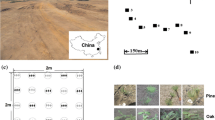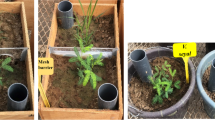Abstract
The role of ectomycorrhizal fungi on mineral nutrient mobilization and uptake is crucial for tree nutrition and growth in temperate forest ecosystems. By using a “mineral weathering budget” approach, this study aims to quantify the effect of the symbiosis with the ectomycorrhizal model strain Laccaria bicolor S238N on mineral weathering and tree nutrition, carrying out a column experiment with a quartz/biotite substrate. Each column was planted with one Scots pine (Pinus sylvestris L.) non-mycorrhizal or mycorrhizal with L. bicolor, with exception of the abiotic control treatment. The columns were continuously supplied with a nutrient-poor solution. A mineral weathering budget was calculated for K and Mg. The pine shoot growth was significantly increased (73%) when plants were mycorrhizal with L. bicolor. Whatever their mycorrhizal status, pines increased mineral weathering by factors 1.5 to 2.1. No difference between non-mycorrhizal and mycorrhizal pine treatments was revealed, however, mycorrhizal pines assimilated significantly more K and Mg. This suggests that in our experimental conditions, L. bicolor S238N improved shoot growth and K and Mg assimilation in Scots pine mainly by increasing the uptake of dissolved nutrients, linked to a better exploration and exploitation of the soil by the mycorrhizal roots.





Similar content being viewed by others
References
Ahonen-Jonnarth U, Van Hees PAW, Lundström US et al (2000) Production of organic acids by mycorrhizal and non-mycorrhizal Pinus sylvestris L. seedlings exposed to elevated concentrations of aluminium and heavy metals. New Phytol 146:557–567
Ahonen-Jonnarth U, Göransson A, Finlay RD (2003) Growth and nutrient uptake of ectomycorrhizal Pinus sylvestris seedlings treated with elevated Al concentrations. Tree Physiol 23:157–167
April R, Keller D (1990) Mineralogy of the rhizosphere in forest soils of the eastern United States-Mineralogic studies of the rhizosphere. Biogeochemistry 9:1–18
Arocena JM, Glowa KR (2000) Mineral weathering in ectomycorrhizosphere of subalpine fir (Abies lasiocarpa (Hook.) Nutt.) as revealed by soil solution composition. For Ecol Manag 133:61–70
Balogh-Brunstad Z, Keller CK, Dickinson J et al (2008a) Biotite weathering and nutrient uptake by ectomycorrhizal fungus, Suillus tomentosus, in liquid-culture experiments. Geochim Cosmochim Acta 72:2601–2618
Balogh-Brunstad Z, Keller CK, Gill RA et al (2008b) The effect of bacteria and fungi on chemical weathering and chemical denudation fluxes in pine growth experiments. Biogeochemistry 88:153–167
Barber SA (1995) Soil nutrient bioavailability: a mechanistic approach. Wiley, New York, USA
Baum C, Stetter U, Makeschin F (2002) Growth response of Populus trichocarpa to inoculation by the ectomycorrhizal fungus Laccaria laccata in a pot and a field experiment. For Ecol Manag 163:1–8
Blum JD, Klaue A, Nezat CA et al (2002) Mycorrhizal weathering of apatite as an important calcium source in base-poor forest ecosystems. Nature 417:729–731
Boyle JR, Voigt GK (1973) Biological weathering of silicate materials. Implications for tree nutrition and soil genesis. Plant Soil 38:191–201
Brandes B, Golbold DL, Kuhn AJ et al (1998) Nitrogen and phosphorus acquisition by the mycelium of the ectomycorrhizal fungus Paxillus involutus and its effect on host nutrition. New phytol 140:735–743
Calvaruso C, Turpault MP, Frey-Klett P (2006) Root-associated bacteria contribute to mineral weathering and to mineral nutrition in trees: a budgeting analysis. Appl Environ Microbiol 72:1258–1266
Casarin V, Plassard C, Hinsinger P et al (2004) Quantification of ectomycorrhizal fungal effects on the bioavailability and mobilization of soil P in the rhizosphere of Pinus pinaster. New Phytol 163:177–185
Chalot M, Javelle A, Blaudez D et al (2002) An update on nutrient processes in ectomycorrhizas. Plant Soil 244:165–175
Cromack K Jr, Sollins P, Grostein WC et al (1979) Calcium oxalate accumulations and soil weathering in mats of the hypogeous fungus Hysterangium crassum. Soil Biol Biochem 11:463–468
Di Battista C, Selosse MA, Bouchard D et al (1996) Variations in symbiotic efficiency, phenotypic characters and ploidy level among different isolates of the ectomycorrhizal basidiomycete Laccaria bicolor strain S238. Mycol Res 100:1315–1324
Drever JI (2005) Surface and ground water, weathering, and soils. In: Holland HD, Turekian KK (eds) Treatise on geochemistry 5. Elsevier, Amsterdam
Duponnois R, Garbaye J (1991) Mycorrhization helper bacteria associated with the Douglas fir-Laccaria laccata symbiosis: effects in aseptic and in glasshouse conditions. Ann For Sci 48:239–251
Finlay RD (2004) Mycorrhizal fungi and their multifunctional roles. Mycologist 18:91–96
Frey-Klett P, Pierrat JC, Garbaye J (1997) Location and survival of mycorrhiza helper Pseudomonas fluorescens during establishment of ectomycorrhizal symbiosis between Laccaria bicolor and Douglas fir. Appl Environ Microbiol 63:139–144
Gadd GM (2007) Geomycology: biogeochemical transformation of rocks, minerals, metals and radionuclides by fungi, bioweathering and bioremediation. Mycol Res 111:3–49
Glowa KR, Arocena JM, Massicotte HB (2003) Extraction of potassium and/or magnesium from selected soil minerals by Piloderma. Geomicrobiol J 20:99–111
Hagerberg D, Thelin G, Wallander H (2003) The production of ectomycorrhizal mycelium in forests: Relation between forest nutrient status and local mineral sources. Plant Soil 252:279–290
Harley JL (1989) The significance of mycorrhiza. Mycol Res 92:129–139
Heinonsalo J, Klett P, Pierrat JC et al (2004) Fate, tree growth effect and potential impact on soil microbial communities of mycorrhizal and bacterial inoculation in a forest plantation. Soil Biol Biochem 36:211–216
Hinsinger P (1998) How do plant roots acquire mineral nutrients? Chemical processes involved in the rhizosphere. Adv Agron 64:225–265
Hinsinger P, Jaillard B, Dufey JE (1992) Rapid weathering of a trioctahedral mica by roots of Ryegrass. Soil Sci Soc Am J 56:977–982
Hoffland E, Kuyper TW, Wallander H et al (2004) The role of fungi in weathering. Front Ecol Environ 5:258–264
Jentschke G, Brandes B, Kuhn AJ et al (2000) The mycorrhizal fungus Paxillus involutus transports magnesium to Norway spruce seedlings. Evidence from stable isotope labeling. Plant Soil 220:243–246
Jongmans AG, Van Breemen N, Lundstrom U et al (1997) Rock-eating fungi. Nature 389:682–683
Kelly E, Chadwick OA, Hilinski TE (1998) The effect of plants on mineral weathering. Biogeochemistry 42:21–53
Kernaghan G (2005) Mycorrhizal diversity: cause and effect? Pedobiologia 49:511–520
Landeweert R, Hoffland E, Finlay RD et al (2001) Linking plants to rock: ectomycorrhizal fungi mobilize nutrients from minerals. Trends Ecol Evol 16:248–253
Le Tacon F, Bouchard D, Churin JL et al (2005) Mycorhization contrôlée du Douglas et du chêne. For Entrep 164:33–37
Leyval C, Berthelin J (1991) Weathering of a mica by roots and rhizospheric micro-organisms of pine. Soil Sci Soc Am J 55:1009–1016
Marschner H (1995) Mineral nutrition of higher plants, 2nd edn. Academic, London
Marschner H, Dell B (1994) Nutrient uptake in mycorrhizal symbiosis. Plant Soil 159:89–102
Martin F, Aerts A, Ahrén D et al (2008) The genome of Laccaria bicolor provides insights into mycorrhizal symbiosis. Nature 452:88–92
Pachlewski R, Packlewska J (1974) Studies on symbiotic properties of mycorrhizal fungi of pine (Pinus sylvestris) with the aid of the method of mycorrhizal synthesis in pure culture on agar. Forest Research Institute, Warsaw
Paris F, Bonnaud P, Ranger J et al (1995) In vitro weathering of phlogopite by ectomycorrhizal fungi. 1. Effect of K+ and Mg2+ deficiency on phyllosilicate evolution. Plant Soil 177:191–201
Paris F, Botton B, Lapeyrie F (1996) In vitro weathering of phlogopite by ectomycorrhizal fungi. 2. Effect of K+ and Mg2+ deficiency and N sources on accumulation of oxalate and H+. Plant Soil 179:141–150
Quoreshi AM, Timmer VR (2000) Early outplanting performance of nutrient-loaded containerized black spruce seedlings inoculated with Laccaria bicolor: a bioassay study. Can J For Res 30:744–752
Robert M, Berthelin J (1986) Role of biological and biochemical factors in soil mineral weathering. In: Huang PM (ed.) Interactions of soil minerals with natural organics and microbes. Soil Sci Soc Am, Madison, Wi, pp 453–495
Rosling A, Lindahl BD, Taylor AFS et al (2004) Mycelial growth and substrate acidification of ectomycorrhizal fungi in response to different minerals. FEMS Microbiol Ecol 47:31–37
Rousseau JVD, Sylvia DM, Fox AJ (1994) Contribution of ectomycorrhiza to the potential nutrient-absorbing surface of pine. New Phytol 128:639–644
Smith SA, Read D (1997) Mycorrhizal symbiosis, 2nd edn. Academic, London
Spyridakis DC, Chesters G, Wilde SA (1967) Kaolinisation of biotite as a result of coniferous and deciduous seedling growth. Soil Sci Soc Am Proc 31:203–210
Torres Aquino M, Plassard C (2004) Dynamics of ectomycorrhizal mycelial growth and P transfer to the host plant in response to low and high soil P availability. FEMS Microbiol Ecol 48:149–156
Van Breemen N, Finlay RF, Lundström U et al (2000) Mycorrhizal weathering: a true case of mineral plant nutrition. Biogeochemistry 49:53–67
Van Hees PAW, Rosling A, Lundström US et al (2006) The biogeochemical impact of ectomycorrhizal conifers on major soil elements (Al, Fe, K and Si). Geoderma 136:364–377
Van Schöll L, Smits MM, Hoffland E (2006) Ectomycorrhizal weathering of the soil minerals muscovite and hornblende. New Phytol 171:805–814
Wallander H (2000) Uptake of P from apatite by Pinus sylvestris seedlings colonised by different ectomycorrhizal fungi. Plant Soil 218:249–256
Wallander H, Wickman T (1999) Biotite and microcline as potassium sources in ectomycorrhizal and non-mycorrhizal Pinus sylvestris seedlings. Mycorrhiza 9:25–32
Wallander H, Johansson L, Pallon J (2002) PIXE analysis to estimate the elemental composition of ectomycorrhizal rhizomorphs grown in contact with different minerals in forest soil. FEMS Microbiol Ecol 39:147–156
Yuan L, Huang J, Li X et al (2004) Biological mobilization of potassium from clay minerals by ectomycorrhizal fungi and eucalypt seedling roots. Plant Soil 262:351–361
Acknowledgements
We acknowledge K. Bateman for review of the English language, A. Kohler, G. Nourrisson, J.L. Churin, and P. Vion for technical help. This work was supported by the Andra (Agence nationale pour la gestion des déchets radioactifs) and by the Lorraine Region.
Author information
Authors and Affiliations
Corresponding author
Additional information
Responsible Editor: Katharina Pawlowski.
An erratum to this article can be found at http://dx.doi.org/10.1007/s11104-011-0915-7
Rights and permissions
About this article
Cite this article
Christophe, C., Marie-Pierre, T., Stéphane, U. et al. Laccaria bicolor S238N improves Scots pine mineral nutrition by increasing root nutrient uptake from soil minerals but does not increase mineral weathering. Plant Soil 328, 145–154 (2010). https://doi.org/10.1007/s11104-009-0092-0
Received:
Accepted:
Published:
Issue Date:
DOI: https://doi.org/10.1007/s11104-009-0092-0




